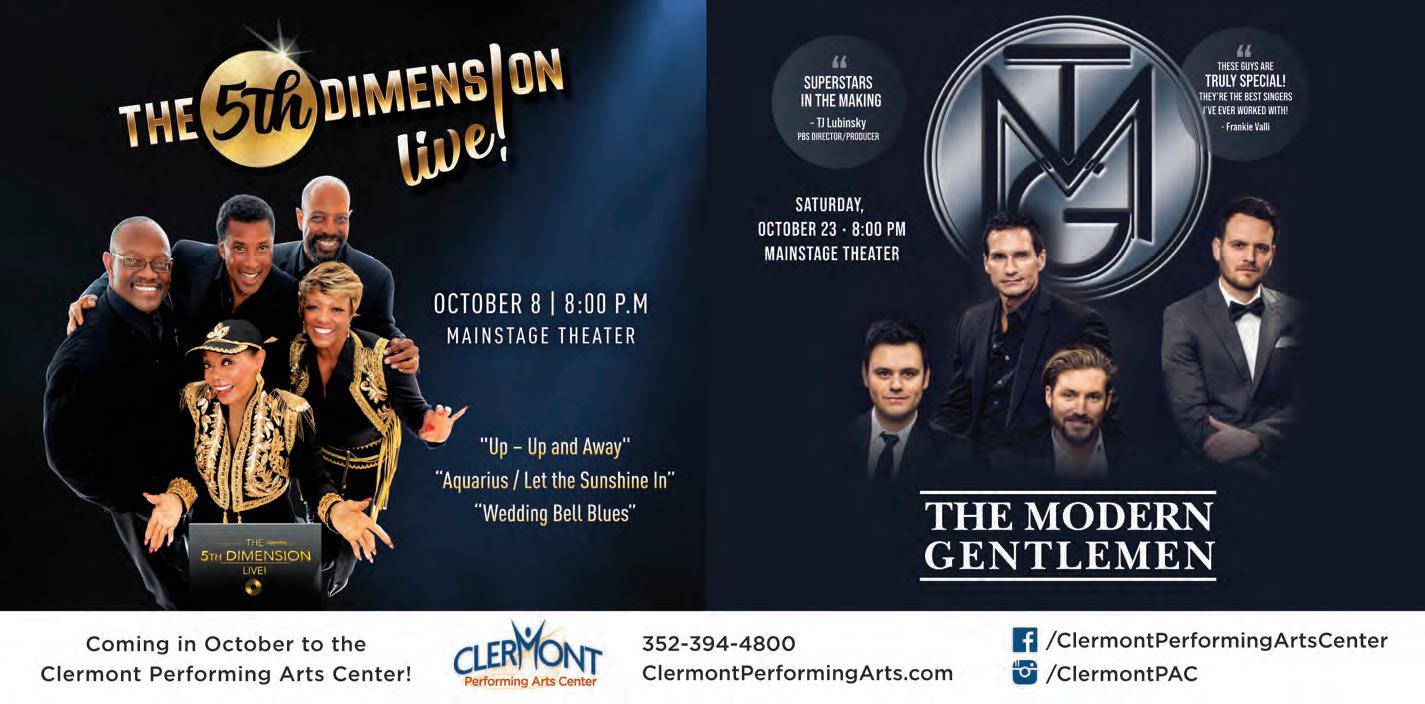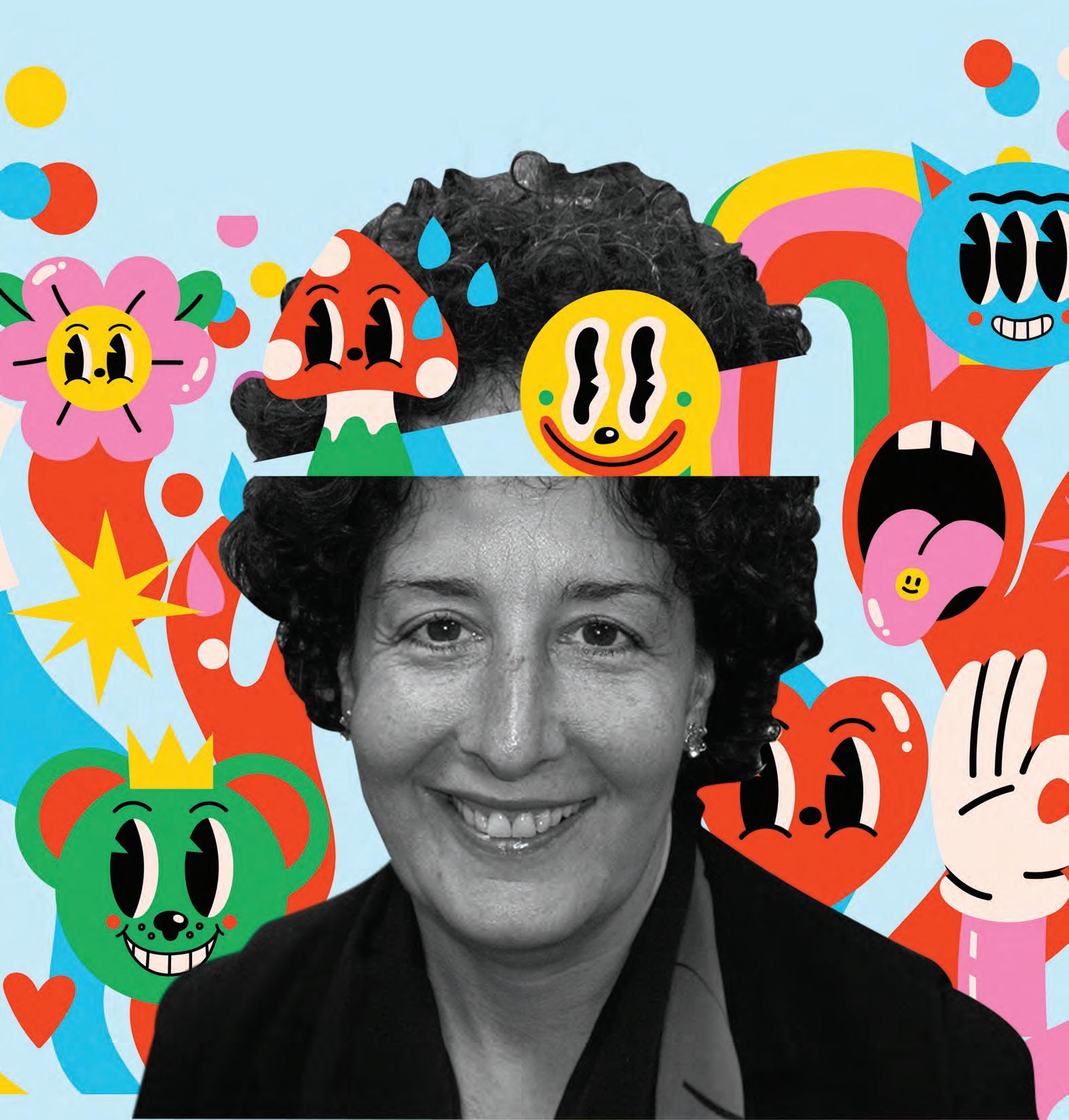
9 minute read
Cover story: Global Peace Film Festival
IMAGINE!
Nina Streich’s Global Peace Film Festival returns for a 19th year
Advertisement
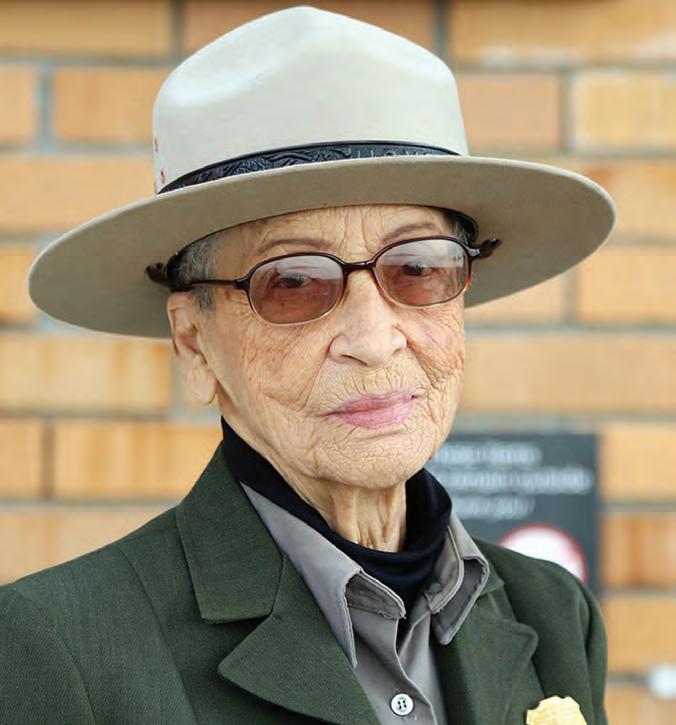
BY MATTHEW MOYER
This year’s Global Peace Film Festival opened on Tuesday — the International Day of Peace — and it’s a welcome return for this showcase of cinema with a social conscience.
For the next two weeks, local film fans will have a chance to experience a challenging and well-curated slate of movies exploring themes of peace and conflict resolution.
In 2020, GPFF organizers developed a hybrid model of online screenings and presentations, alongside a small number of in-person screenings, as a communityminded pivot in the face of a pandemic.
This year, festival organizers are expanding the number and scale of in-person screenings but keeping what worked as far as virtual screenings and events. The first week of the festival, already underway, kicked off with an opening-night screening at Enzian Theater, to be followed by in-person screenings through Sept. 26 at the Winter Park Library. Next week — Sept. 27-Oct. 3 — feature films can be viewed virtually through Eventive and free short films through the festival’s YouTube channel.
“I have to credit Kelly DeVine, the artistic director and programmer for the festival with a really diverse lineup of films. I can never single out a specific [favorite] film. If I did, I wouldn’t tell anyone,” Streich chuckles.
And it’s not just movies on offer this year, but a series of in-person and Zoom Q&A sessions with filmmakers, and two art exhibitions: one at CityArts, and another of art from local public school students online. “Do the Evolution at CityArts in downtown Orlando showcases the work of Leonardo Bianchi, presenting 12 new works custom-curated for the GPFF,” says Streich. “Since 2006, the GPFF has presented the K-12 Student Peace Art Exhibit from students throughout the Orange County Public School system. Their talent is amazing and their ideas are inspiring.”
But has the last year-plus of unending bad news shaken Streich’s faith in the GPFF’s mission at all?
“Not at all! In fact, it has strengthened my faith in film, and in fact all creative arts, as a positive force for societal change. The creativity that so many filmmakers have shown throughout the pandemic has been really exciting,” Streich concludes.
See you at the movies.
GLOBAL PEACE FILM FESTIVAL
live screenings, Sept. 21-26 virtual festival, Sept. 27-Oct. 3 peacefilmfest.org free-$125
Ms. Betty Reid Soskin
No Time to Waste: The Urgent Mission of Betty Reid Soskin
(52 minutes, 2020)
Screening 8 p.m. Wednesday, Sept. 22, Winter Park Public Library Available online 12:01 a.m. Monday, Sept. 27, through 11:45 p.m. Sunday, Oct. 3
Most of the National Park Service’s more famous offerings operate on a time scale that is beyond the comprehension of human minds. History is on display at Arches and Yellowstone, but it’s a matter of geologic time.
Betty Reid Soskin’s role in the National Park Service has the exact opposite effect of staring at million-year-old rock formations. The 99-year-old African American park ranger tells the history of the United States to remind guests that we’re not as far removed from the Bad Old Days as we thought, because they really weren’t that long ago.
In Carl Bidleman’s No Time to Waste, Soskin’s story is put on full display. It spans from her born-enslaved great-grandmother — who was alive well into Soskin’s 20s — to the presidency of Barack Obama. Bidleman tells this story in the same hands-off manner of the NPS, getting out of the way to let Soskin explain it in her own words.
Through Soskin, we see the history that America would just as soon forget. Her life connects the “peculiar institution” to the Great Flood of 1927. It runs from the still-segregated homefront in World War II through the Civil Rights era and, eventually, to her own post in the NPS as a sort of official truth-teller.
Soskin’s view of history as an “ascending spiral,” hitting on the same key points from a slightly better vantage each time, is backed up by the occasional historical asides provided by the filmmakers. The hour-long doc largely serves to show history is too messy and ugly to fit on anything you might find in a visitors center gift shop. — Alex Galbraith
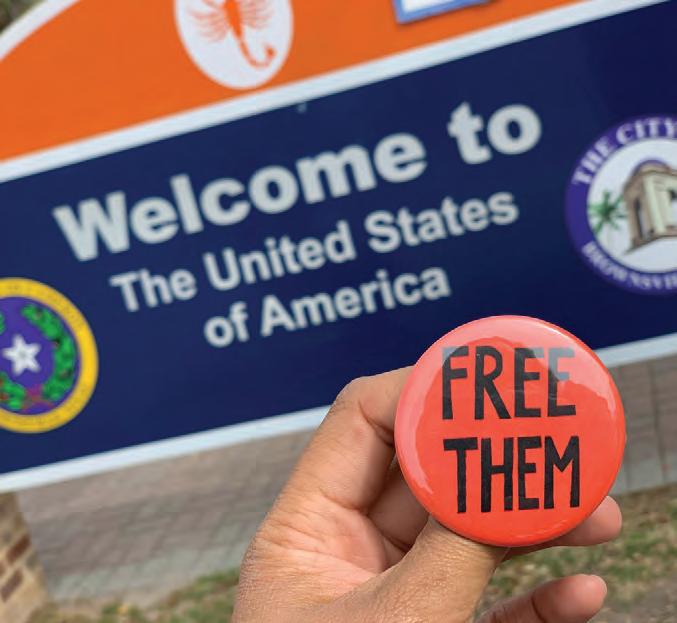
A still from Heyden Pedigo’s campaign commercial
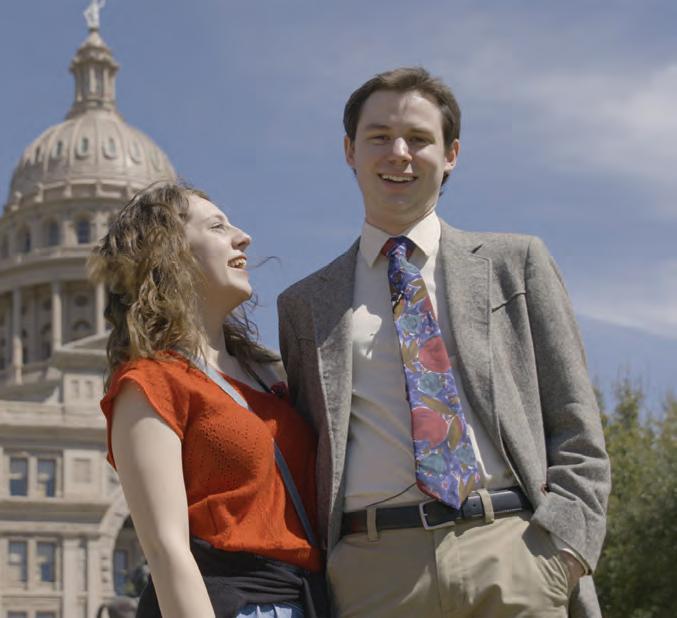
Kid Candidate
(2021, 67 minutes)
Screening 3 p.m. Saturday, Sept. 25, Winter Park Public Library Available online 12:01 a.m. Monday, Sept. 27, through 11:45 p.m. Sunday, Oct. 3
In 1979, Dead Kennedys singer and agit-punk legend Jello Biafra ran for mayor of San Francisco as an independent. Biafra’s campaign was built around his caustic, nihilistic humor and over-the-top pronouncements — all cars banned citywide, all businessmen required to wear clown suits within city limits. He finished third in a field of 10. Amarillo’s Heyden Pedigo, the subject of Kid Candidate, while a denizen of the underground, avant-garde arts world, is no Jello Biafra.
But maybe that’s not such a bad thing?
The titular Kid Candidate, Pedigo, is a mid-20s resident of Amarillo, Texas, and though he is an experimentally inclined guitar player and part of a loose collective of outré filmmakers and enthusiasts, he’s the polar opposite of the types you’ll find at noise shows around the country. He has an appealing, aw-shucks idealism filtered through a 21st-century lens, like Mr. Smith Goes to Washington presented as an episode of Nathan for You.
The film follows Pedigo’s beyond-longshot campaign for a City Council seat in Amarillo. The campaign grew out of a funny and eccentric video Pedigo made with friends that quite by accident became a Reddit sensation and a catalyst for Pedigo to turn a jokey campaign video into the real thing.
Of course, anyone watching this film can (spoiler alert) telegraph Pedigo’s loss from the opening credits, but the thrust of the film is Pedigo unexpectedly growing into his role as a candidate, bereft of guile and, by his own choice, campaign donations. What started as something absurd becomes something that could legitimately impact lives, muses a wide-eyed Pedigo early on.
As much as it is a look at Pedigo’s political journey — aided and abetted by his supportive wife, ragtag artist friends, a delightfully caustic local lawyer and activist, and heartfelt interactions with the South Sudanese immigrant community — it’s also an investigaton into and indictment of the old money oligarchy (emphasis on “old”) that holds Amarillo’s civic life in tight, gilded clutches.
Confounding expectations from the start, Kid Candidate is an endorsement for giving a damn about where you live. — Matthew Moyer
A button distributed by Team Brownsville
A Break for Impact
(57 minutes, 2020)
Screening 6 p.m. Wednesday, Sept. 22, Winter Park Public Library Available online 12:01 a.m. Monday, Sept. 27, through 11:45 p.m. Sunday, Oct. 3
College spring break can be a mind-altering experience, no matter what you spend the week doing. For a group of UCF students, their 2020 trip was a true eyeopener. While Texas’ South Padre Island hosted its usual party influx, this group was 45 minutes away in Brownsville, at one of the more than 300 U.S. Customs and Border Protection ports of entry.
University of Central Florida legal studies professor Irene Pons and four students from her Immigration Law and Policy class, accompanied by a UCF videographer, traveled to the southern border to volunteer with a legal organization handling asylum seekers. When that group nixed video documentation, they had to switch gears.
They ended up assisting a group called Team Brownsville in their humanitarian efforts at the Matamoros tent camp, the largest gathering of U.S. asylum seekers in Mexico — distributing food and clothing, helping with art classes for the children. While there they met members of a group called Witness at the Border, and ended up witnessing — and, crucially, documenting — much, much more than they had expected to see.
While the lack of sanitary facilities and basic human necessities in the camp was distressing, and the system of which and how many immigrants are allowed to cross over seems cruelly arbitrary, the students observe something much worse: the deportation flights in which the United States ships shackled men, women and children to Honduras and El Salvador, regardless of their country of origin. The level of effort the CBP puts in to attempt to hide what they’re doing, and how they do it, is telling, amounting to an admission of shame.
And who knows? Shame is as likely, if not more so, than nobility to motivate change. As Lee Goodman of Witness at the Border says while the students record the proceedings, it’s important to “make sure that the doers know that there are watchers.”
History is repeating itself right now with thousands of Haitian migrants camping under a bridge in Del Rio, Mexico. Who will be the watchers? — Jessica Bryce Young


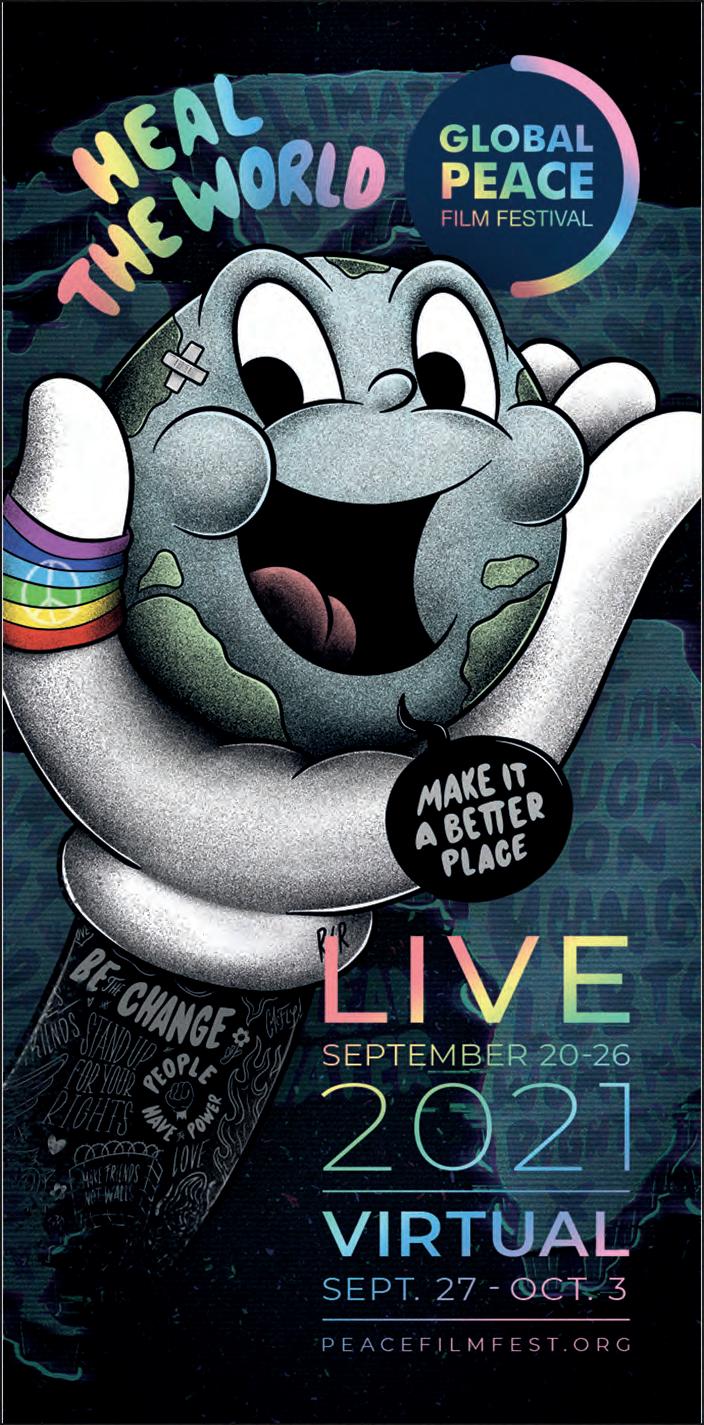
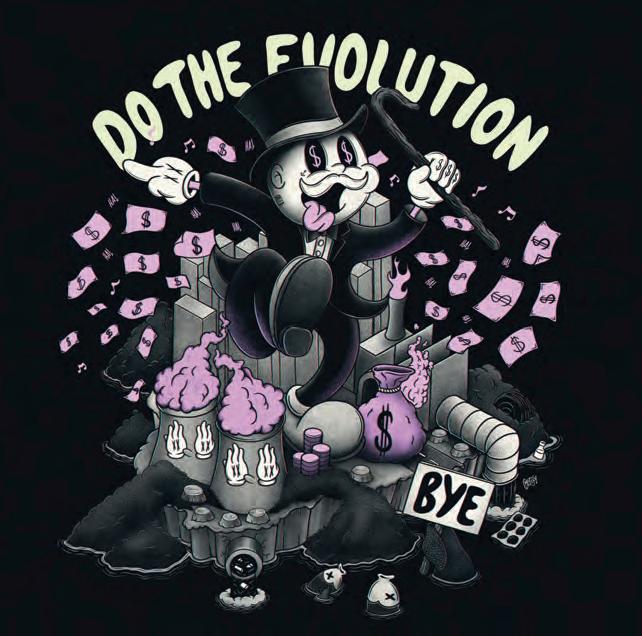
Above: ‘Do the Evolution’; right: ‘I Don’t Care’; both by GMcFly
Eel the world
Leo Bianchi’s sinuous, wiggly-squiggly characters draw attention, then spark intention
BY JESSICA BRYCE YOUNG
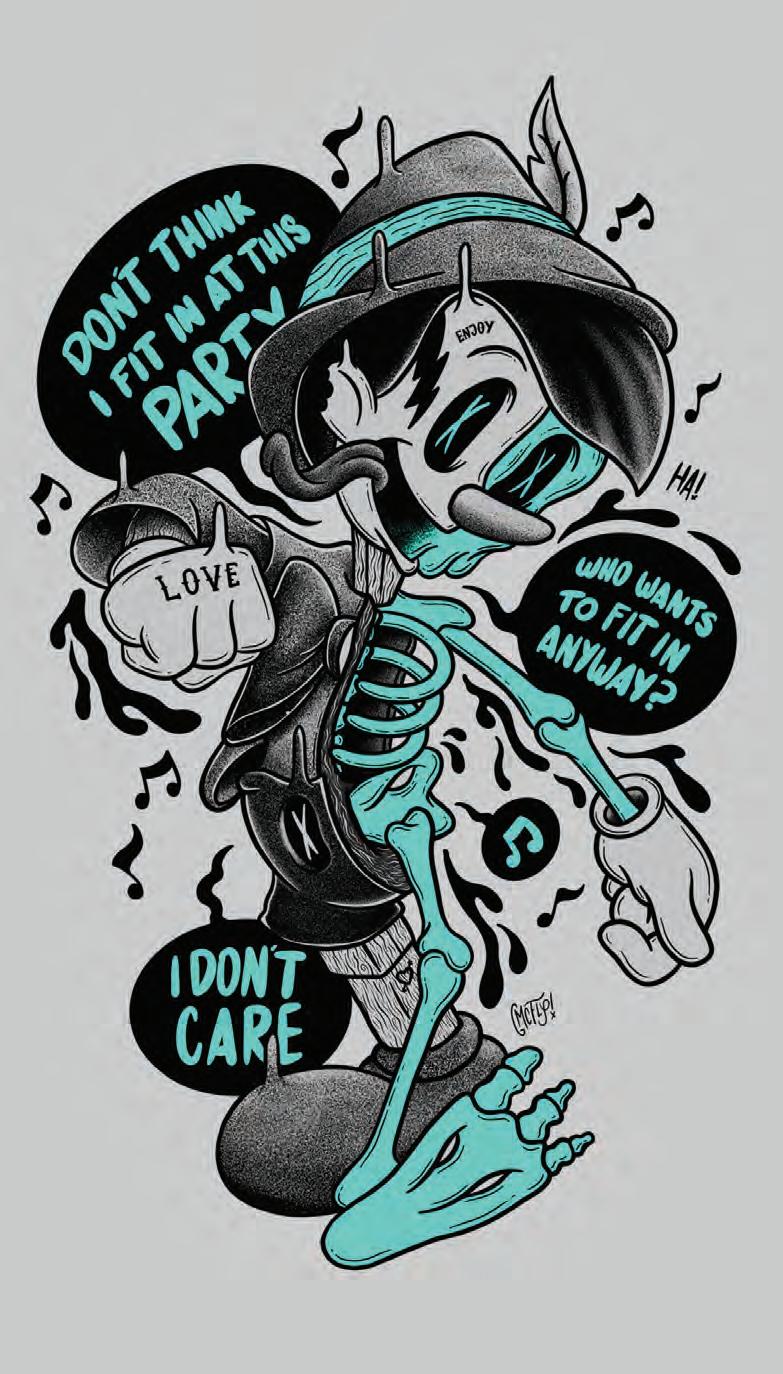
A1974 pop single that could be the unofficial theme song of the Global Peace Film Festival asked plaintively, “What’s so funny ’bout peace, love and understanding?” At the 2021 iteration of GPFF, artist Leo Bianchi brings a dozen pop songs to visual life in service of the fest. Not that one, but still, it’s a playlist deeply concerned with change for the better.
GPFF founder Nina Streich chose Michael Jackson’s “Heal the World” as the official theme of the fest for its pro-change, pro-child lyrics. And “Heal the World” is just one of Bianchi’s paintings at Do the Evolution, the GPFF-affiliated exhibition currently hanging at CityArts.
Pearl Jam’s “Do the Evolution,” Imagine Dragons’ “Radioactive,” “Land of Confusion” by Genesis and more are illustrated by Bianchi — or in fact, by his artist’s nom de brosse, GMcFly — in Do the Evolution. Their sinuous, splurty lines belie the weighty subject matter, draw-
ing in the viewer and turning that grin outside-in. Argentine-born Bianchi, a designer currently working with Orlando-based branding firm Larimer & Co., brings a vintage-cartoony vibe to his works. He’s inspired by the “rubber-hose style” (so called for the characters’ rubbery, jointless limbs) of early animators like Ub Iwerks, Tex Avery and the Fleischer Brothers — but even if DO THE EVOLUTION you know nothing about through Oct. 17 the history of animation, CityArts, 39 S. Magnolia Ave you’ll respond to these peacefilmfest.org/cityarts bendy bois, advocates free all for social justice. “For some, the United States is a true manifestation of the ‘American Dream,’ yet, for many individuals both nationally and globally, basic human and civil rights are abridged and jeopardized with a judicial system that has eroded confidence and trust,” says Bianchi. “It is my wish that my art opens up dialogue and sparks change.” The sparks will fly at CityArts through Oct. 17. feedback@orlandoweekly.com
